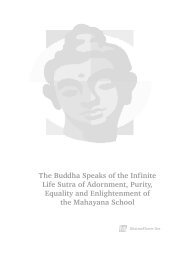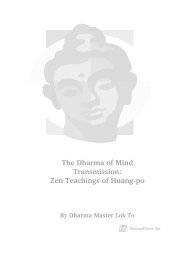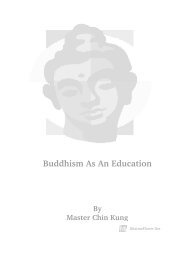THE FOUR NOBLE TRUTHS By Ajahn Sumedho - DharmaFlower.Net
THE FOUR NOBLE TRUTHS By Ajahn Sumedho - DharmaFlower.Net
THE FOUR NOBLE TRUTHS By Ajahn Sumedho - DharmaFlower.Net
Create successful ePaper yourself
Turn your PDF publications into a flip-book with our unique Google optimized e-Paper software.
<strong>THE</strong> SECOND <strong>NOBLE</strong> TRUTHWhat is the Noble Truth of the Origin of Suffering?It is craving which renews being and is accompanied by relish andlust, relishing this and that: in other words, craving for sensualdesires, craving for being, craving for non-being. But whereon doesthis craving arise and flourish? Wherever there is what seems lovableand gratifying, thereon it arises and flourishes.There is this Noble Truth of the Origin of Suffering: such was thevision, insight, wisdom, knowing and light that arose in me aboutthings not heard before.This Noble Truth must be penetrated to by abandoning the origin ofsuffering....This Noble Truth has been penetrated to by abandoning the origin ofsuffering: such was the vision, insight, wisdom, knowing and lightthat arose in me about things not heard before.[Samyutta Nikaya LVI, 11]The Second Noble Truth with its three aspects is: ‘There is the originof suffering, which is attachment to desire. Desire should be let go of.Desire has been let go of.’The Second Noble Truth states that there is an origin of suffering andthat the origin of suffering is attachment to the three kinds of desire:desire for sense pleasure (kama tanha), desire to become (bhavatanha) and desire to get rid of (vibhava tanha). This is the statement ofthe Second Noble Truth, the thesis, the pariyatti. This is what youcontemplate: the origin of suffering is attachment to desire.THREE KINDS OF DESIREDesire or tanha in Pali is an important thing to understand.What is desire? Kama tanha is very easy to understand. This kind ofdesire is wanting sense pleasures through the body or the othersenses and always seeking things to excite or please your senses -that is kama tanha. You can really contemplate: what is it like whenyou have desire for pleasure? For example, when you are eating, if youare hungry and the food tastes delicious, you can be aware of wantingto take another bite. Notice that feeling when you are tastingsomething pleasant; and notice how you want more of it. Don’t justbelieve this; try it out. Don’t think you know it because it has beenthat way in the past. Try it out when you eat. Taste something









